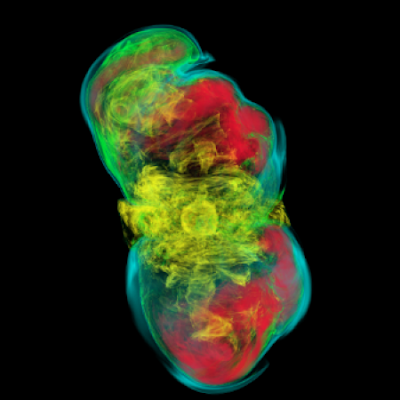A massive stellar core not quite managing to transition to a supernova explosion because of a small "kink" instability in its rotational axis.
Credit: Philipp Mösta and Sherwood Richers
What happens when massive stars collapse? One potential result is a core-collapse supernova.
Astronomers can make observations of such events that tell us what is happening on the surface of a star when it explodes in a supernova, but it is considerably more difficult to know what is driving the process inside the star at its hot, dense core.
Astrophysicists attempt to simulate these events based on the properties of different kinds of stars and knowledge of the fundamental interactions of mass and energy, hopefully providing astronomers with ready predictions that can be tested with observational data.
In a recent publication, Caltech postdoctoral scholar Philipp Mösta and Christian Ott, professor of theoretical astrophysics, present a three-dimensional model of a rapidly rotating star with a strong magnetic field undergoing the process of collapse and explosion . . . or at least trying to.
 Stars with a very rapid spin and a strong magnetic field are comparatively rare: no more than one in a hundred massive stars (those at least 10 times the mass of our sun) have these features.
Stars with a very rapid spin and a strong magnetic field are comparatively rare: no more than one in a hundred massive stars (those at least 10 times the mass of our sun) have these features.
According to Mösta and Ott's research, when these bodies undergo core collapse, small perturbations around its axis of rotation may inhibit the process that would ordinarily lead to a supernova explosion.
Previous models of the collapse of rapidly rotating magnetized stellar cores assumed perfect symmetry around the axis of rotation. In effect, these models were two-dimensional.
The models yielded the expectation that as these cores collapsed, the strong magnetic field combined with the rapid spin would squeeze the stellar material out into two narrow "jets" along the axis of symmetry, as shown at left.
 Assuming perfect symmetry around the axis of rotation can be excused in part as a matter of simplifying the scenario so that it could be simulated on an ordinary computer rather than the kind of supercomputer that Mösta and Ott's three-dimensional simulations require: 20,000 processors to output 500 terabytes—over 500 trillion bytes—of data that represent only some 200 milliseconds in time.
Assuming perfect symmetry around the axis of rotation can be excused in part as a matter of simplifying the scenario so that it could be simulated on an ordinary computer rather than the kind of supercomputer that Mösta and Ott's three-dimensional simulations require: 20,000 processors to output 500 terabytes—over 500 trillion bytes—of data that represent only some 200 milliseconds in time.
But, says Ott, "Even working with paper and pencil, writing down equations and discussing them with other theoretical astrophysicists, we should have known that small perturbations can trigger an instability in the stellar core."
"Nothing in nature is perfect. As we learn from this model, even small asymmetries can have a dramatic effect on the process of stellar collapse and the subsequent supernova explosion."
More information: The paper, "Magnetorotational Core-collapse Supernovae in Three Dimensions," is available online: authors.library.caltech.edu/45202/1/2041-8205_785_2_L29.pdf
Credit: Philipp Mösta and Sherwood Richers
What happens when massive stars collapse? One potential result is a core-collapse supernova.
Astronomers can make observations of such events that tell us what is happening on the surface of a star when it explodes in a supernova, but it is considerably more difficult to know what is driving the process inside the star at its hot, dense core.
 |
| Philipp Mösta |
 |
| Christian Ott |
 Stars with a very rapid spin and a strong magnetic field are comparatively rare: no more than one in a hundred massive stars (those at least 10 times the mass of our sun) have these features.
Stars with a very rapid spin and a strong magnetic field are comparatively rare: no more than one in a hundred massive stars (those at least 10 times the mass of our sun) have these features. According to Mösta and Ott's research, when these bodies undergo core collapse, small perturbations around its axis of rotation may inhibit the process that would ordinarily lead to a supernova explosion.
Previous models of the collapse of rapidly rotating magnetized stellar cores assumed perfect symmetry around the axis of rotation. In effect, these models were two-dimensional.
The models yielded the expectation that as these cores collapsed, the strong magnetic field combined with the rapid spin would squeeze the stellar material out into two narrow "jets" along the axis of symmetry, as shown at left.
 Assuming perfect symmetry around the axis of rotation can be excused in part as a matter of simplifying the scenario so that it could be simulated on an ordinary computer rather than the kind of supercomputer that Mösta and Ott's three-dimensional simulations require: 20,000 processors to output 500 terabytes—over 500 trillion bytes—of data that represent only some 200 milliseconds in time.
Assuming perfect symmetry around the axis of rotation can be excused in part as a matter of simplifying the scenario so that it could be simulated on an ordinary computer rather than the kind of supercomputer that Mösta and Ott's three-dimensional simulations require: 20,000 processors to output 500 terabytes—over 500 trillion bytes—of data that represent only some 200 milliseconds in time.But, says Ott, "Even working with paper and pencil, writing down equations and discussing them with other theoretical astrophysicists, we should have known that small perturbations can trigger an instability in the stellar core."
"Nothing in nature is perfect. As we learn from this model, even small asymmetries can have a dramatic effect on the process of stellar collapse and the subsequent supernova explosion."
More information: The paper, "Magnetorotational Core-collapse Supernovae in Three Dimensions," is available online: authors.library.caltech.edu/45202/1/2041-8205_785_2_L29.pdf








No comments:
Post a Comment